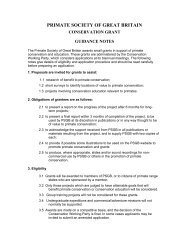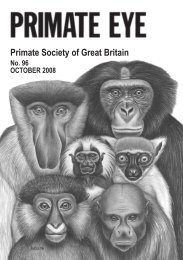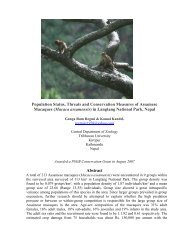2009 Vol 99.pdf (2.45mb) - Primate Society of Great Britain
2009 Vol 99.pdf (2.45mb) - Primate Society of Great Britain
2009 Vol 99.pdf (2.45mb) - Primate Society of Great Britain
Create successful ePaper yourself
Turn your PDF publications into a flip-book with our unique Google optimized e-Paper software.
38<br />
monkey. Her chapter is followed by Yukiko Shimooka and others<br />
describing the current knowledge on demography and group composition.<br />
The final section deals with spider monkeys and their interactions with<br />
humans. The spider monkey conservation chapter concludes that if existing<br />
protected areas are managed and enforced, spider monkeys could continue<br />
to exist, albeit with the loss <strong>of</strong> a few subspecies. However, this may be a bit<br />
optimistic in my experience <strong>of</strong> working in and around protected areas in<br />
Central America. I was pleased to see a chapter on spider monkey<br />
ethnoprimatology by Laura Cormier and Bernardo Urbani, who clearly<br />
demonstrate the importance <strong>of</strong> spider monkeys to indigenous peoples as<br />
both a food and cultural resource. These authors clearly establish that the<br />
species is hunted throughout its range and a chapter might have been<br />
included with data collated from the various studies carried out on hunting<br />
in the Neotropics. This information might then be used to assess the<br />
sustainability <strong>of</strong> spider monkeys into the future if hunting continues at the<br />
current rate.<br />
It’s a great pity this book is so expensive because it is a very useful resource<br />
for those <strong>of</strong> us interested in spider monkeys. However, it does reveal large<br />
gaps in our current knowledge. Hopefully this will inspire more people to<br />
study spider monkeys particularly in the many areas where no research<br />
presently occurs.<br />
SIÂN S. WATERS<br />
Durham University<br />
SEXUAL SELECTION AND THE ORIGINS OF HUMAN MATING<br />
Alan F. Dixson (<strong>2009</strong>).<br />
Oxford University Press<br />
ISBN: 9780199559428 (Hardback) £70.00<br />
Evolutionary psychology has resulted in an explosion <strong>of</strong> research that, while<br />
providing some fascinating insights into human mating behaviour, has been<br />
heavily criticized for adhering to a number <strong>of</strong> unfounded assumptions. Alan<br />
Dixson’s Sexual Selection and the Origins <strong>of</strong> Human Mating Systems,<br />
scheduled to coincide with the 200th anniversary <strong>of</strong> Darwin’s birth,<br />
provides an invaluable analysis <strong>of</strong> cross-species research in order to place<br />
human sexuality in the context <strong>of</strong> a wealth <strong>of</strong> empirical evidence relating to<br />
our evolutionary history. He begins, for example, with a discussion <strong>of</strong><br />
diverse approaches to the analysis <strong>of</strong> human mating systems (including<br />
advances in the fossil record, genetics and our understanding <strong>of</strong> postcopulatory<br />
sexual selection and primate social lives), each <strong>of</strong> which is<br />
employed to address arguments surrounding issues such as sperm<br />
competition, cryptic female choice, copulatory patterns, oestrus and sexual






